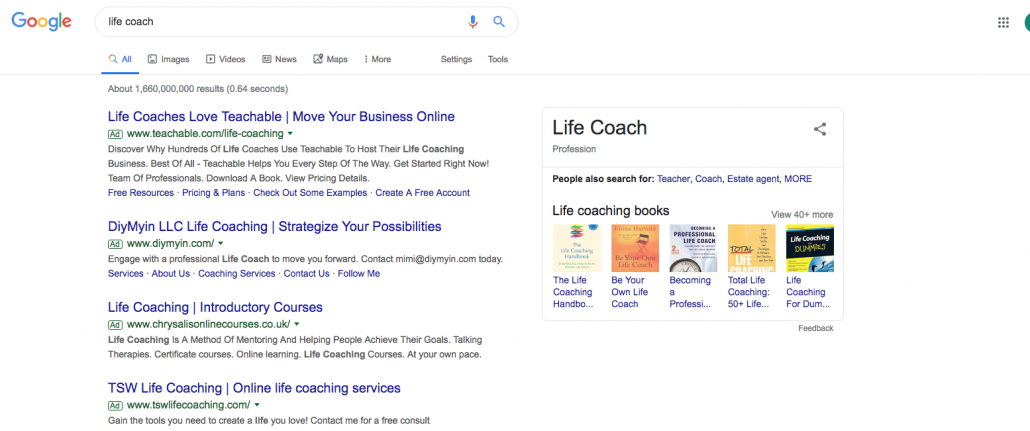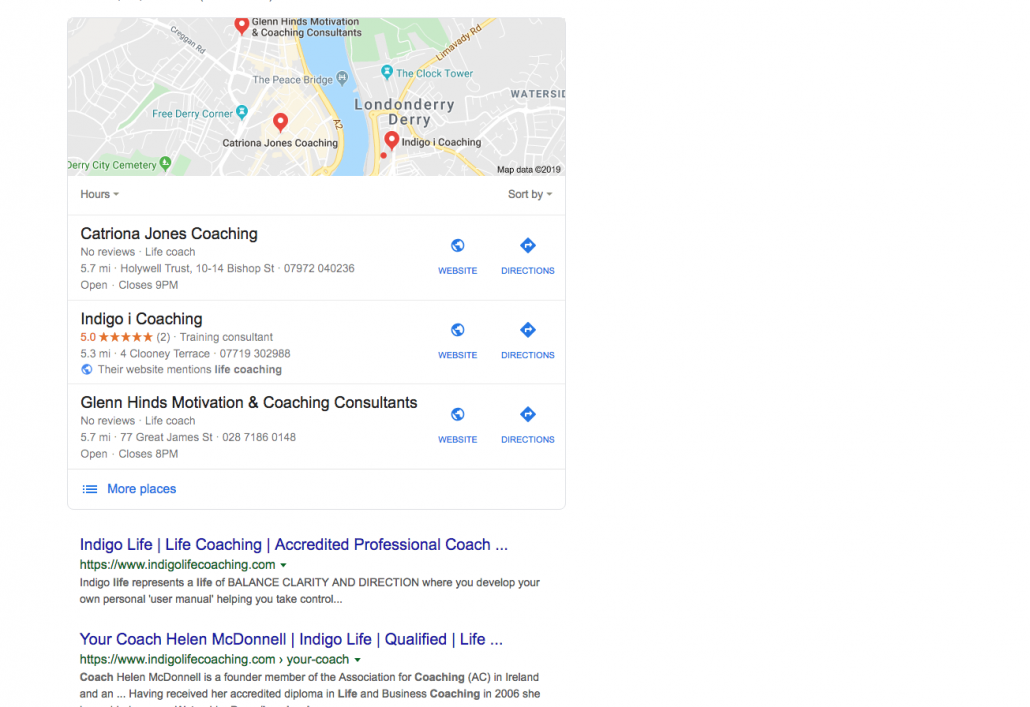5 Ways to use SEO to Improve Website Visibility
One of the most frequent problems I hear clients say is that their website is not being found on Google.
In this post I give you 5 ways to use SEO to improve your website visibility.
Over 90% of all website content never gets found on Google. I want to help your website content to be in the 10% that will get found.
If you’ve gone to the trouble of creating a website, designing and gathering up images and text, then it is so disappointing when you don’t see your website on Page 1 of Google for the keywords you want to get found for.
In this article I present 5 ways you can start to increase your websites visibility on Google. These are:
- Understanding what Google really wants
- Know your Customer
- Get Backlinks to your website
- Ensure your Website is Optimised for SEO
- Use Google my Business
You want to be top of Page 1 in the search results page? Then read on through my 5 ways to use SEO to improve website visibility and start getting more customers to your website.
1. Understanding what Google Really wants!
Google is the most popular search engine in the world today. 3.5 billion Google searches are made every day. So making an effort to understand what they need is well worth your while.
Businesses generally want (some depend on) Google to ‘get found’ by customers for their products and services. And yet so many are unwilling to find out how exactly to make this happen. We expect Google to provide this FREE marketing platform, yet we grumble when we don’t see our website there, when we haven’t put the effort into satisfying their search criteria.
What Google really wants is to provide an easy, intuitive and enjoyable journey for it’s searchers (ie you and me, the people who ‘search for’ something).
They have developed sophisticated algorithms and programmes to produce the most relevant answer to a searchers query. Which is why when you type in a keyword you get a page of results.
For example if I type in ‘life coach‘ I will see the page below, with an info box on the left and Paid results in the first 4 positions.
This is your immediate challenge. If you are not using sponsored ads (also called PPC & Google Adwords), then you are hoping to get found in a position below this top 4.
When I search for ‘life coach derry’ I see the local map plus Organic results immediately below (happy to see two of my clients here 😀 ). This is where you want your business or service to get found – on the map for local search and on the Organic Results.
Google has produced these results based on the following: 1) as a result of the keywords I used, 2) website content is relevant to my keyword search, and 3) my location.
This is just a very light skim over what Google wants. If you simply remember Google’s priority is for users to have a good experience, ie seeing relevant results, choosing one and enjoying a good website experience, then you are onto a winner.
2. Knowing your Customer
The more you know about your customer ( or ‘audience’), the more powerful your online marketing efforts will become.
Really understanding your customer, who they are, their needs and desires and where they hang out online, is essential for SEO. This ties in with the point above, ie once you know and understand your customer, you can create relevant, useful content for them on your website. If you do this, Google will know, they will find you and will include your site in the search results.
What do your customers need or desire? Where will they start looking, what questions will they ask, what words will they use. List it all out so that you have a list of potential questions that your customers will ask.
For example if you are a HR Consultant working for small businesses, what are your customers greatest needs? It might be employment contracts. So if they go to Google with a query such as ‘help with employment contracts’ you can provide the answers.
There are many websites which will help you create your customer persona (just Google ‘create a customer persona’). But you can get lost in a sea of templates and long blogs and end up with nothing done. You can also carry out keyword research using the Google Planner (you have to create an ad account, but you can work around not starting actual ads) and Ubersuggest. But again you can get lost and overwhelmed with this approach.
Start with the basics. Write down 5 questions your customers typically ask and answer these in a blog post. It doesn’t have to be 1000’s of words long. The most important thing is that it’s relevant.
Blogs also bring in more traffic. According to Neil Patel Businesses that blog regularly generate 55% more visitors to their sites than those that don’t.
Knowing and understanding your customers needs, and creating relevant content, is the key to improve website visibility.

3. Get Backlinks to your Website
Backlinks is one of the most important factors in SEO – it simply refers to a link on another website linking back to your website. Once you have your content created on your website, you can distribute it, let other website owners know about it and request to get backlinks to your website.
Now were not talking about getting a link from your cousins Hairdressing website to your Business Consultancy website! That’s clearly not relevant and Google will detect this. What we are talking about is sharing your site with other relevant directories, blogs and websites.
For your Business Consultancy website, a link from the local Chamber of Commerce is highly relevant. And as they probably have a reasonable volume of traffic, Google will respect the fact that they link to you and reward you with a higher position on the search results page. Although that’s the basis of Backlinks, what you need is to have many relevant websites linking back to your site.
So for example create an article on ‘5 tips to improve your business productivity’, then share this with website owners who have similar customers. Eg local chamber of commerce websites, business improvement blogs, complimentary business blogs eg HR blogs or websites). Build relationships with the owners of other websites or blog sites, and request that your article or blog is posted. Ensure you have some ‘anchor’ text linking back to your website – ie hyperlink a few relevant words to a page on your website. This is not a direct plug but a link to further relevant content, so its more natural. Google likes this.
You can also use relevant directories, professional organisations and industry blogs. Always check that they allow a ‘follow’ link as some will add your link but with a ‘no follow’ link.
There many platforms that you can use to check how many backlinks you have to your website. However many of these again are complicated and expensive for the average small business owner, or solo fempreneur. You can find out yourself for free by using Google Search Console.
The most important thing is to remember that high quality content can get shared. Build relationships with relevant people and organisations and get your content and links to your website shared by them.

4. Ensure your Website is Optimised for SEO
Google also loves websites to be optimised for SEO. This refers to a few areas:
- Completing SEO meta data on your website pages and blog posts – ie SEO titles, meta description, image Alt text etc
Every website building platform should have an area adding in for SEO data. I use WordPress and the Yoast plugin which allows me to create the meta data which Google sees and shows up in search results. For example if I search for ‘diet plan to loose weight’, I will get results like this:
The SEO title is the blue text, the URL contains keywords and the Meta description simply explains what’s on the page which helps me to choose what to click on.
Anther key factor is completing the Image ALT text, which basically explains to Googles search bot what the image/page is about. You can use the keywords here which may help your image to get found in Google Images, another way to lead people to your website.
Are keywords necessary?
Nowadays keywords are Not the most essential element of getting found on Google.
However you should still a focus keyword for each page on your website, it helps to organise your content and keep a clear intention for the page. Don’t keep repeating it unless it fits into the content naturally. Include it if possible in the URL of the page ( ie the page or post address eg www.whatever.com/this-keyword-here..)
- Ensuring your website is performing well – ie quick speed times, sound structure, no broken links
So how do you know if your website is performing well? There are many tools to test page speed and uploading time, eg Web Page Test . These will give you an indication as to whether you have any major issues, and if you do send me an email I may be able to help you out with that. Also check your site for any broken links – Google does not like! Use Screaming Frogs free tool to find any.
Also make sure your sitemap is submitted to Google. If you are using Yoast on WordPress it will be done automatically for you. Again any issues, do here drop me a link.
Most importantly, use your common sense to check your website for errors, structure and stability!
- Ensuring your website is Mobile Responsive and optimised for mobile phones
Mobile Responsive means that your website easily adapts to the mobile (or table) screen and you don’t have to pinch it or zoom in to see the content.
Mobile Optimised means that your website is structured and designed for mobile screens. If at this stage your website is not mobile optimised then Google won’t like your site and they say they actively avoid showing non mobile optimised sites.
Brian Dean is a super duper SEO guy, one of the most respected in the business. He says that 58% of all searches in Google are now done from a mobile device. This is simply going to increase. And back to what Google want – they want to satisfy their web searchers. It’s all about making the visitors journey easy and intuitive.
See the difference in my home page on both Desktop and Mobile. On mobile I’ve ditched the image and get straight to the point… quick, easy to scroll through, intuitive.
- Having an SSL security certificate which adds an extra layer of security
Just check the browser bar to see if your site address starts with http:// or https:// – https means you have some sort of SSL security and both for your peace of mind and for Google you are a bit more secure.
![]()
If you have a WordPress website you can get and extra security plugin to help prevent against hacking, we use WordFence.
And finally we get on to…
5. Use Google My Business!
Google My Business![]() (GMB) is one of the most powerful ways to improve a business’ local search engine optimisation and online visibility. It’s a free tool which helps you manage your online presence across Google.
(GMB) is one of the most powerful ways to improve a business’ local search engine optimisation and online visibility. It’s a free tool which helps you manage your online presence across Google.
Sometimes you think you are on GMB because you might see your business name on the map. But check it out, as your business address might have been found by Google, but not registered to you. You can benefit so much more by registering, verifying and editing your business information, you can both help customers to find you and tell them all about your business.
The main benefits of having a GMB account is that you can provide so much more information to potential customers. When people search for a business on Google, they may see information about your business in a box that appears in their search results. The information in the box, called a Knowledge Panel, can help customers discover and contact your business.
You can add business details, images, get reviews and get properly placed on the Google Map in search results.
One of the most powerful ways to get attention is by creating posts in GMB. You can add blog posts which can include an image, text, a Call To Action and a URL that you can use to link to a landing page or your website. Each post has a limit of 300 words, and the first 100 characters (or fewer) can appear in the business’ Knowledge Panel.
You can also add an event, post about a sale or feature a product!
Conclusion
So if you’ve made it to the end, you now know at least 5 ways to use SEO to improve your website visibility. If you would like to learn more please join me on one of my upcoming workshops (in Donegal & Derry Nov 19) please see this link, or click one of the buttons below – I would love to see you there!
Letterkenny
Fri 15th Nov 2019
9:00 am – 12:30 pm
Mount Errigal Hotel Letterkenny
Registration €55.00
Derry
Thu 28th Nov 2019
9:00 am – 12:30 pm
Best Western White Horse Hotel Derry
Registration £47.00









